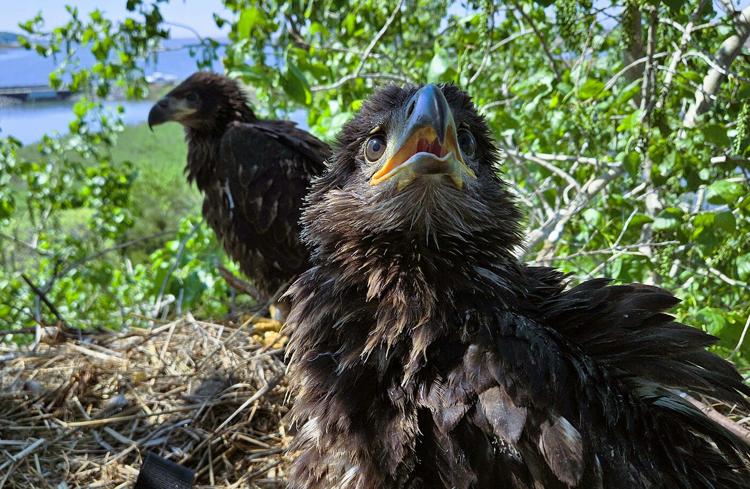By Jeremy Cox
Bay Journal
Some eagle-eyed wildlife biologists have made a surprising discovery at Poplar Island.
That’s the island in Maryland’s portion of the Chesapeake Bay that the U.S. Army Corps of Engineers and Maryland Port Authority have been rebuilding over the last 25 years. What was once almost entirely open water is now more than 1,700 acres of rock-ringed land.
One of the primary aims behind creating the island was to reestablish some of the habitat that waterfowl and shorebirds have lost around the Chesapeake to rising seas, erosion and shoreline development. According to the latest count, about 40 bird species have successfully nested on Poplar and produced young.
But one iconic species wasn’t among them — until now.
In early May a veteran U.S. Fish and Wildlife Service scientist named Craig Koppie shimmied up a cottonwood tree on a spit of higher terrain on the north side of the island. He peered down into a stick-laden nest known to have been built by bald eagles the previous fall. Inside were a pair of newly hatched eaglets — a male and a female.
“It’s that quote where ‘If you build it, they will come,’ ” said Peter McGowan, a Fish and Wildlife biologist who has been involved in the Poplar project since the mid-1990s. “If you have this nice habitat, things will move in, and they will move in quick. You never know what’s going to show up, and that’s one of the great parts of the job.”
McGowan said he isn’t surprised that eagles would nest on the island. He thought it would only be a matter of time. Still, the dynamics behind the island’s reconstruction didn’t make it a likely candidate to host eagles.
Once home to 100 people
The original Poplar Island once sprawled across more than 1,100 acres a few miles west of Tilghman Island on the Eastern Shore. At its height, Poplar was home to a population of about 100 people. There were several farms, a school, a church, a post office and a sawmill.
Like dozens of other low-lying islands around the Chesapeake Bay, though, Poplar was washing away. By the 1920s, the last of its residents had fled to higher ground. By the late 1990s, only a few acres of land remained.
Enter the Paul S. Sarbanes Ecosystem Restoration Project. Named after the U.S. senator from Maryland who championed the effort, the project is rebuilding the island using mud dredged up from Baltimore’s shipping channels to keep its port open to navigation.
The first mud delivery came in 2001, and the last is expected to arrive in the mid-2030s.
To make the island as hospitable as possible for water-loving birds, engineers designed Poplar to poke only slightly above the surrounding tide. The landscape is largely given over to marshes and mudflats. The only trees planted so far have been a handful in a small test plot.
That doesn’t bode well for eagles, who generally seek out trees as their nesting spots. But nature appears to have intervened on their behalf, McGowan said.
The cottonwood tree that harbors the young eagles sprang up on its own. It’s part of a clutch of trees on about an acre’s worth of slightly higher ground surrounded by marsh. Despite the harsh environment, some have grown more than 60 feet tall, McGowan estimates. Cottonwoods — a type of poplar, aptly enough — are known to be fast growers.
Eagles have been spotted flying overhead and hunting around Poplar since the earliest days of its restoration, he noted. A stone’s throw away from Poplar lies tree-lined Coaches Island and its cache of four eagle nests (two of which are active).
20 years wait
But McGowan and his colleagues had to wait about 20 years into the project before they noticed the first signs that eagles were trying to nest on Poplar. It started with a pair of eagles’ effort to build a nest on the metal grate top of a water-control structure in 2020.
“Obviously, it wasn’t the best place for an eagle to nest,” he said.
The nest didn’t last. A second attempt atop a spillway the following year also failed. Then, the scientists noticed a mound of sticks growing larger in a cottonwood tree where a crow’s nest had been. It was too big for the supporting branches and eventually tumbled out of the tree.
Another nest in the same tree started taking shape last fall. McGowan can’t say for sure whether its builders are the same eagles that had enlarged the crow’s nest, but he suspects they are. This time, the nest was more centered over the trunk and less likely to fall.
By March, the amount of time the eagles spent perched on the nest suggested that there were eggs inside of it. Koppie’s climb in May confirmed the presence of two eaglets. Before descending, he attached purple bands on their legs, identifying one bird as “09/E” and the other as “10/E.”
Disaster nearly struck toward the end of May when a strong storm knocked the nest out of the tree. Biologists quickly reconstructed a new nest on a nearby pole and put the eaglets in it. Soon, their parents were back to taking care of them, McGowan said.
The young birds will probably take wing by June, McGowan said. Will their parents try again in the future? McGowan is optimistic that they will.
“That’s a good place to raise a family,” he said. “So, they should come back next year and in following years.”
Jeremy Cox is a Bay Journal staff writer based in Maryland. You can reach him at [email protected].




Recent Comments